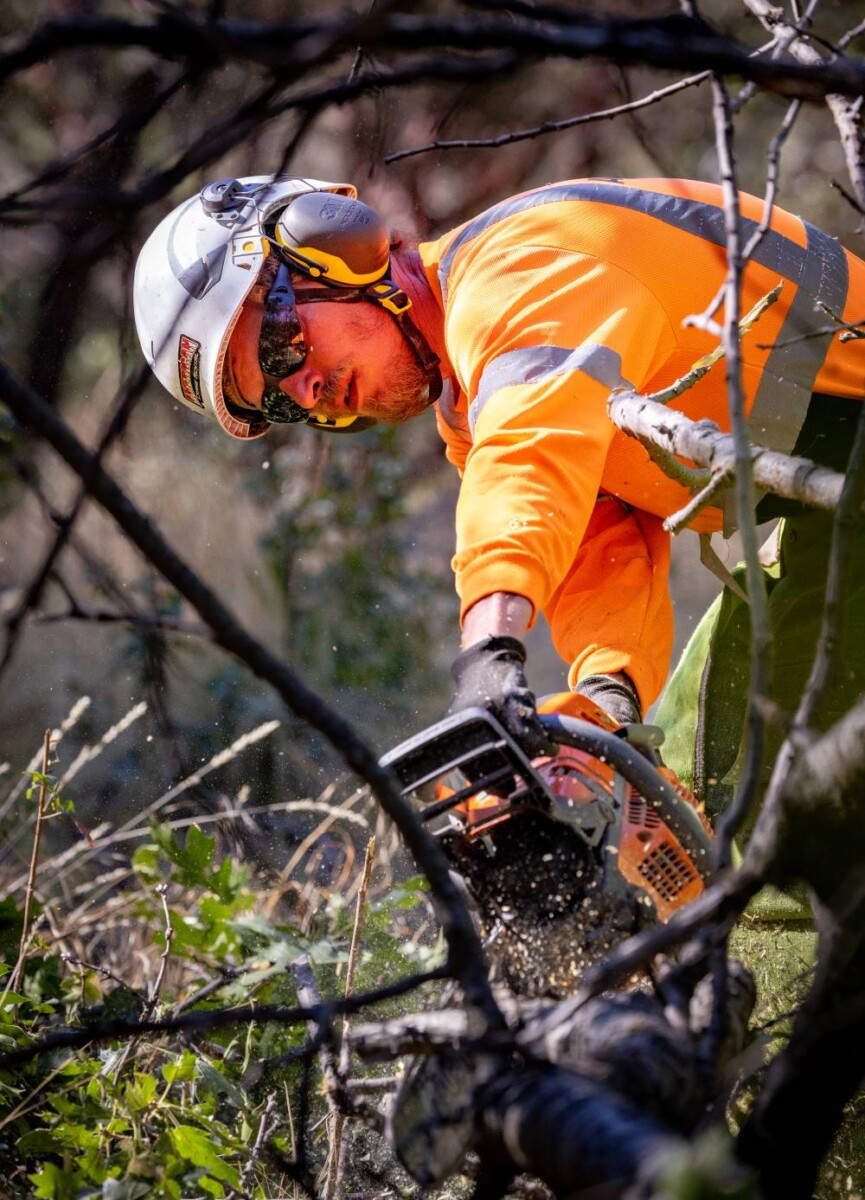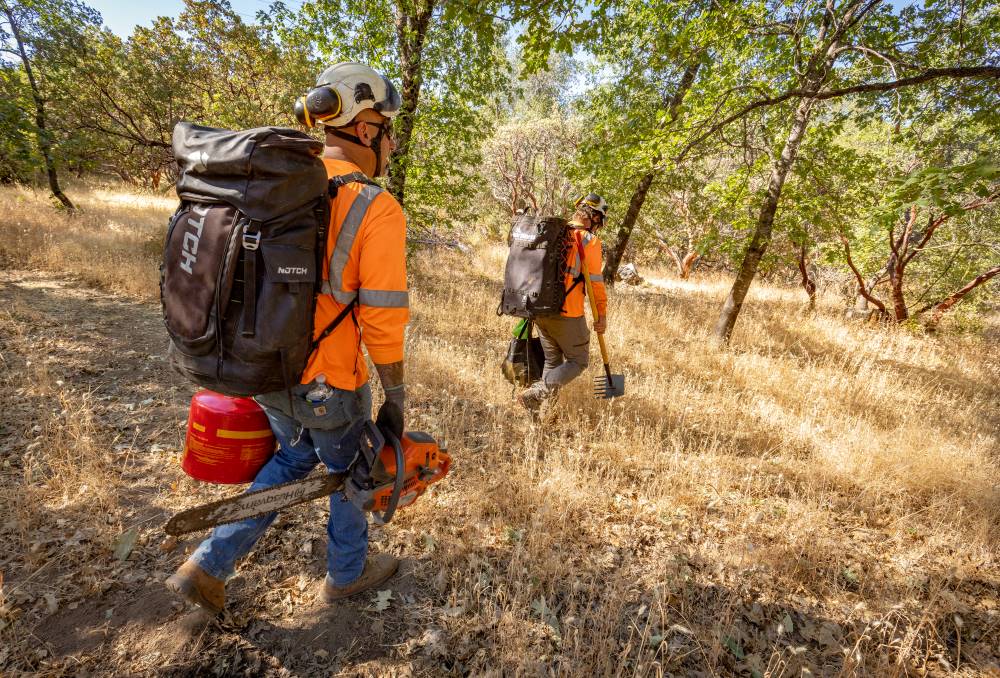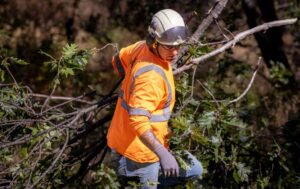
Apprentice Climber Mitchell Marcus
At a worksite located in the exact geographical center of California, nestled amongst the groves of North Fork, a hard-working IBEW 1245 vegetation management crew from ArborWorks, Inc. was dispatched to remove several hazardous trees on a hot day in mid-July. Dead or dying trees within ten feet of overhead power lines pose an immediate threat to facilities which require removal as the remedy; otherwise, considerable damage may ensue.
But before they began climbing and cutting, the crew had to complete a series of essential safety-related procedures.
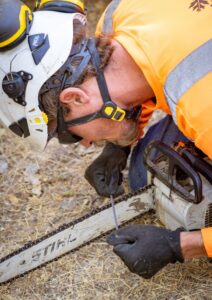
Apprentice Climber Aaron Huffstuler
“The first thing we need to do is get our truck out of the way and coned off safely, with two signs and wheel chocks,” explained Foreman Vance Myers. “Then we need to get all the safety paperwork in line, get our JSA [job safety analysis] filled out, along with the fire assessment sheets, plus our emergency action plans. We have two climber gears out, and we’re going to inspect those before we go up a tree.”
The logistics of tree removal can be quite challenging given the terrain. The bucket truck is left behind while the three-person crew geared up to begin their journey.
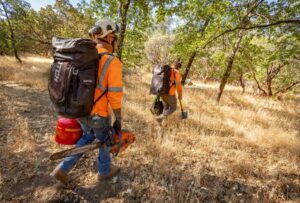 “We have about a quarter mile hike, roughly carrying 60 pounds per person,” says Myers. “We each bring four water bottles, gas, oil, a fire station which consists of a backpack pump, a McLeod [hard rake for fire line], a Pulaski [combo fire ax with a hoe], a shovel, a large saw and a small saw for climbing, rope, bag, first aid kit, fire extinguisher, two climb gears. So, a lot of stuff.”
“We have about a quarter mile hike, roughly carrying 60 pounds per person,” says Myers. “We each bring four water bottles, gas, oil, a fire station which consists of a backpack pump, a McLeod [hard rake for fire line], a Pulaski [combo fire ax with a hoe], a shovel, a large saw and a small saw for climbing, rope, bag, first aid kit, fire extinguisher, two climb gears. So, a lot of stuff.”
Once the crew arrived at their destination, the work commenced to remove the trees, with the first tree being a little tricky.
As Myers explained, “The one spar that leans towards the power lines hangs over a shed. I need to rig it down with ropes. I’m going to climb and then rig pieces back to not hit the shed, to mitigate the lines.”

Foreman Vance Myers
Myers — who is both an IBEW 1245 Shop Steward and Safety Steward, and also part of 1245’s Keep the Clearance peer safety committee — knows that the union has his back and that of his fellow co-workers.
“The union is here to look out for all of us,” said Myers. “Any time I have any questions or need answers, I’ve been able to call my business rep, Abel Sanchez, and we get things figured out. If my brothers are having an issue with a grievance, they are there to help take care of that. They are there to fight for us.”
Photos by John Storey
“Bajando ramas con las sogas” — Podadores de árboles para el despeje de líneas del Local 1245 realizando su trabajo en North Fork
Un caluroso día de mediados de julio, se envió a una laboriosa cuadrilla de manejo de vegetación de ArborWorks, Inc, miembros del IBEW 1245, a remover varios árboles peligrosos. Los árboles muertos o moribundos a menos de diez pies de las líneas eléctricas aéreas representan una amenaza inmediata para las instalaciones, y la solución es removerlos; de lo contrario, podrían producirse daños considerables.
Pero antes de comenzar a trepar y talar, la cuadrilla tuvo que completar una serie de procedimientos esenciales relacionados con la seguridad.
“Lo primero que tenemos que hacer es quitar nuestro camión del camino y colocar conos de seguridad a su alrededor, con dos avisos y cuñas para las ruedas”, explicó el Capataz Vance Myers. “Luego, tenemos que completar todos los documentos de seguridad, llenar nuestro JSA [análisis de seguridad en el trabajo], junto con las hojas de evaluación de incendios, además de nuestros planes de acción de emergencia. Sacamos los equipos para dos escaladores, y los inspeccionamos antes de trepar a un árbol”.
La logística de la remoción de árboles puede ser bastante desafiante según el tipo de terreno. Dejamos atrás el camión grúa mientras que la cuadrilla de tres personas se prepara para comenzar su jornada.
“Tenemos por delante una caminata de un cuarto de milla, cargando un peso de aproximadamente 60 libras por persona”, dice Myers. “Cada uno de nosotros trae cuatro botellas de agua, gas, petróleo, una estación contra incendios que consiste en una bomba de mochila, un McLeod [rastrillo duro para incendios forestales], un Pulaski [hacha/azada contra incendios], una pala, una sierra grande y una sierra pequeña para trepar, soga, bolsa, botiquín de primeros auxilios, extintor de incendios, dos equipos para trepar. Es decir, muchas cosas”.
Una vez que la cuadrilla llegó a su destino, comenzó el trabajo de remoción de árboles. El primer árbol estuvo un poco complicado.
Myers lo explicó así, “La rama que está inclinada sobre las líneas eléctricas cuelga sobre un cobertizo. Necesito bajar la rama usando las sogas. Voy a trepar y luego bajar trozos para no golpear el cobertizo, para mitigar las líneas”.
Myers, quien es Delegado Sindical del IBEW 1245 y también Delegado de Seguridad, y además forma parte del comité de seguridad entre compañeros del 1245, “Mantenga la Distancia” (Keep the Clearance), sabe que tanto él como sus compañeros de trabajo cuentan con el apoyo del sindicato.
“El sindicato está aquí para cuidarnos a todos”, dijo Myers. “Cada vez que tengo preguntas o necesito respuestas, he podido llamar a mi representante de negocios, Abel Sánchez, y obtengo la información que necesito. Si mis hermanos tienen algún problema con una queja, ellos están allí para ayudar a solucionarla. Están allí para luchar por nosotros”.
Fotos por John Storey
